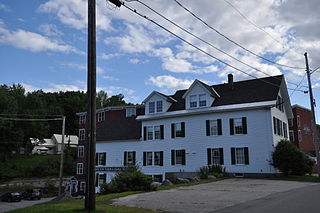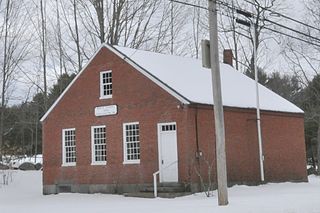
The North Holderness Freewill Baptist Church–Holderness Historical Society Building is an historic church building in Holderness, New Hampshire. Built in 1860 for a Free Will Baptist congregation, it is a little-altered example of a rural vernacular church building. It was added to the National Register of Historic Places in 1986. The building was moved in 1994 from its original site on Owl Brook Road to U.S. Route 3 east of the center of Holderness by the Holderness Historic Society, who now own it.

The West Ward School is a historic school at 39 Prospect Street in Wakefield, Massachusetts. Built in 1847, it is the only surviving Greek Revival schoolhouse in the town. The building was listed on the National Register of Historic Places in 1989. It is now maintained by the local historical society as a museum property.

The Dry Mills Schoolhouse is a historic schoolhouse on Game Farm Road in Gray, Maine. Built about 1857, it is the town's last surviving single-room district schoolhouse, and is now a local museum. The building was added to the National Register of Historic Places listings on December 13, 1996.

The Bass Boarding House is an historic house on Canal Street in Wilton, Maine, United States. It was built in 1860s, and adapted for use as worker housing for G.H. Bass & Co., whose former factory building stands next door. The building, one of a few that survive in Wilton that were adapted in this way, was added to the National Register of Historic Places in 1988. It now houses the Wilton Historical Society's Wilton Farm and Home Museum.

The North School, also known locally as the Brick School, is a historic one-room schoolhouse at 63 Amesbury Street in Kensington, New Hampshire, United States. Built in 1842, it was the only brick schoolhouse built in the town, and is one of its four surviving 19th-century schools. Of those, it is the best-preserved, and is used as a local history museum. It served the town's educational purposes between 1842 and 1956, and is now a local history museum. The building was listed on the National Register of Historic Places in 2013.

The Chandler-Parsons Blacksmith Shop, now the Blacksmith Shop Museum, is a historic blacksmith shop at 107 Dawes Road in Dover-Foxcroft, Maine. Believed to be built in the early 1860s, it is one of a very small number of relatively unaltered rural 19th-century blacksmithies in the state. It is owned and operated by the local historical society as a museum, and was listed on the National Register of Historic Places in 1989.

The Madrid Village Schoolhouse is a historic community building on Reeds Mill Road in the center of the disincorporated township of Madrid, Maine. Built c. 1872, it is the least-altered surviving district school building of twelve originally built in the community. In the later years of the 20th century the school was used for town meetings and offices prior to the town's disincorporation in 2000. The building was listed on the National Register of Historic Places in 1995.

The Temple Intervale School, also known as the District No. 5 Schoolhouse, is a historic one-room district schoolhouse at Intervale and Day Mountain Roads in Temple, Maine. Built in 1810–11, it is one of the oldest surviving schoolhouses in western Maine, and one of its longest-used, with a recorded history of academic usage extending to 1958. The building is now maintained by the local historical society. It was listed on the National Register of Historic Places in 1985.

The former Norridgewock Female Academy, now home to the Norridgewock Historical Society, is a historic school property on Mercer Road, just west of its junction with Upper Main Street in Norridgewock, Maine. Its Greek Revival building was built in 1837, when the school was founded, and was used by that institution until 1860. The building is regionally distinctive as one of a few surviving Greek Revival school buildings with a Greek temple portico. It was listed on the National Register of Historic Places in 1996.

The Division No. 9 School is a historic former one-room schoolhouse on Maine State Route 9 in Wells, Maine. Built in 1900, it is the best-preserved of the town's surviving district school buildings, and is now a museum owned by the town. It was listed on the National Register of Historic Places in 1995.

The Old Tavern is a historic travelers' accommodation at Maine State Route 188 and Long Ridge Road in Burlington, Maine. Built in 1844, it predominantly catered to the lumbermen working on logging drives in the region. The building was acquired by the local historical society in 1984, and is now a local history museum. It was listed on the National Register of Historic Places in 1986.

The District No. 5 School House is a historic school building on Billings Road at School House Lane in Hermon, Maine. Probably built about 1880, it is the rural community's best-preserved one-room schoolhouse, and is now maintained by the local historical society. It was listed on the National Register of Historic Places in 1997.

The District No. 2 School is a historic schoolhouse at Pleasant Street and Caribou Road in Passadumkeag, Maine. Built in the 1840s as a school, it later served as a church, town hall, and library. It is now a museum operated by the local historical society, and was listed on the National Register of Historic Places in 1997.

The Friends School was a historic schoolhouse in the village center of Casco, Maine. Built in 1849, it was a well-preserved example of a 19th-century one-room schoolhouse. Converted to a museum operated by the local historical society, it was listed on the National Register of Historic Places in 1996, and was destroyed by arsonists in 2018. It was located behind the town office building on Maine State Route 121.

The Vernon District Schoolhouse No. 4 is a historic school building at 4201 Fort Bridgman Road in Vernon, Vermont. Built 1848, it is a well-preserved mid-19th century brick district school, which now serves as a local historical museum. It was listed on the National Register of Historic Places in 2005.

The Braintree School, also known as the District 8 School, is a historic school building at 9 Warren Switch Road in Pawlet, Vermont, United States. It is a single-room district schoolhouse built in 1852, and used as a school until 1934. It is now a museum property owned by the Pawlet Historical Society, and was listed on the National Register of Historic Places in 2010.

The Brick School is a historic one-room schoolhouse on Cushman Road in Winslow, Maine. Built about 1810, it is one of the oldest surviving district schools in the state of Maine. It was listed on the National Register of Historic Places in 1977, and is now owned and maintained by the town's historic preservation committee

The Colburn School is a historic schoolhouse on Arnold Road in Pittston, Maine. With an estimated construction date of 1815, this brick schoolhouse is the best-preserved of the town's 19th-century district schools, and served for a time as the town hall. Now a local historical society museum, it was listed on the National Register of Historic Places in 2001.

The Stone Schoolhouse is a historic school building on Bay Point Road in Georgetown, Maine. Built sometime before 1821, it is one of the state's small number of surviving stone district school buildings. It is now a museum property maintained by the local historical society. It was listed on the National Register of Historic Places in 1977.

The District No. 5 School is an historic school building and local history museum at 311 East Road in Petersham, Massachusetts. It is one of two relatively unmodified one-room schoolhouses in the town that were built in 1849. It is presently managed by the local historical society as a local history museum. The building was listed on the National Register of Historic Places in 2016.

















